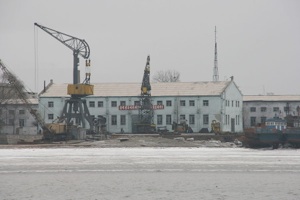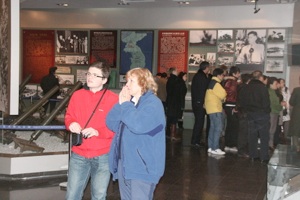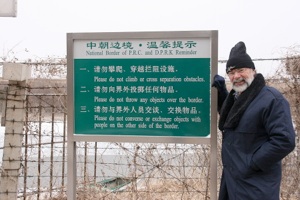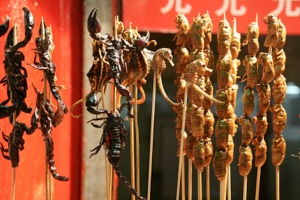Assisted by Di, I have just returned from a week in north-east China leading a group of 18 students for Project Week. While other groups from the College travelled to various destinations in Thailand, Vietnam, Cambodia, Malaysia, Indonesia, Taiwan and the Philippines, our destination was Dandong, China’s border city with North Korea on the Yalu River.
I had been to Dandong once before, but it had been in the heat of summer time. The experience of arriving at windswept Dandong Railway Station on Monday morning when the temperature was -6°C was significantly different! Despite the cold temperatures, the group was certainly very happy to arrive, as we had been travelling by train from Hong Kong for 42 hours, and the experience of walking on solid ground once again was quite reassuring.
The theme of our Project Week trip was ‘peace on the Korean peninsula’. After a quick shower and change of clothes after the long rail journey, our first introduction to Dandong was the appropriately named ‘Broken Bridge’. Built by the Japanese occupation government in the early 1900s, the bridge was bombed by US forces during the Korean War in the early 1950s as it was a major supply line to the Chinese People’s Volunteer forces fighting in the Korean War at the time.
After the Korean War ended (on the day I was born!!!), the spans on the Korean half of the bridge were completely demolished, but the spans were left standing on the Chinese side. In recent years, the Chinese have developed their half of the bridge into a lookout point for people to observe North Korea, complete with binoculars (for a fee) and a souvenir stall. Although it was bitterly cold, we braved the walk across the windswept Broken Bridge to get a closer look at North Korea, just a few hundred metres away on the opposite bank of the Yalu River. It was quite a sobering experience to walk amidst the tangled and broken steel remains of the bombing, noting the bullet holes and damage from flying fragments of steel as we did so.
Returning to the river bank, we made our way past several very cold souvenir sellers, who tried to sell us (predictably) North Korean banknotes, Kim Il Sung badges and North Korean cigarettes, plus (much more surprisingly I thought) playing cards with pornographic photos on the back). Surviving the onslaught of the souvenir sellers, we boarded a small dragon-shaped sightseeing boat to get a closer view of North Korea’s border city (Sinuiju) from the Yalu River.
We could not get as close as we had hoped to the shoreline because the water level was quite low, but we were certainly close enough to see the run-down factories, the propaganda slogans, the fake ferris wheel and some North Korean soldiers playing a game of basketball.
After lunch, we drove to Dandong’s only university, the Liaodong University, to receive a lecture from Professor Man Haifong on the situation in North Korea today. He presented a useful overview of the factors affecting North Korea’s economic, social, political, military and diplomatic situation, all illustrated by his own PowerPoint presentation, after which he answered a small number of questions before he had to rush away to another engagement.
Following Professor Man’s lecture, the students were given an opportunity for free and open conversations with students from the university’s tourism course. Although the Liaodong students were a little shy at first, they soon relaxed and the discussion covered many significant and substantial points.
After dinner that evening, we gathered in a meeting room of the hotel to enjoy the first of two nights of DPRK-themed videos that were designed to open up our thinking about the situation in North Korea. On this first evening, we watched four short documentary films, all made in North Korea, the titles being “Who started the Korean War?”, “Ringleader of the Korean War”, “US Aggressive Armed Spy Ship ‘Pueblo’”, and “Answer of Korea”. After the movies, it was time to enjoy some good sleep in our first stable beds for three nights.
Our initial visit on our second day in Dandong was the War Museum, or as it is officially known, the “Museum of the War to Resist US Aggression and Aid Korea”. Telling the story of the Korean War from a Chinese perspective, the Museum contained some remarkable memorabilia and photographs of the conflict, mostly labelled in ‘extremely unambiguous’ language, portraying the horrors and astonishing sacrifices of the war which saw over 1 million of the Chinese Volunteer forces (of almost 4 million) killed.
The exhibits in the Museum were remarkable, including graphic maps that outlined each phase of the conflict, Peng Dehuai’s original UAZ vehicle, many rare and unpublished photographs including some of US atrocities (some of which showed germ and bacteriological warfare), original propaganda leaflets dropped on American soldiers to encourage them to defect, stories of amazing heroism and sacrifice, a huge diorama showing a key battle, and a large outside field with aircraft, tanks and other equipment. In summary, the Museum was a sober monument to the futility of war – a place not to be rushed but to be savoured as a series of profound reflections.
Following a very welcome hot lunch, we heraded off to the Great Wall at Hu Shan (Tiger Mountain), which is the eastern end of the Ming Dynasty Wall. At Hu Shan, the Wall twists and turns in a snake-like manner over a two kilometre mountain stretch that rises sharply to a ridge that overlooks North Korea before descending even more steeply to the narrow stream that forms the Chinese-DPRK border. As we arrived at Hu Shan it started snowing, providing the beautiful (though cold) spectacle of a white landscape as we climbed the Great Wall – an especially memorable experience for the many students who had never seen snow.
Despite the snow, the air was surprisingly clear, giving us good views across the bleak winter farming landscape of North Korea. Descending from the summit of Hu Shan, we walked along a narrow track right beside the border, noticing that the concrete and barbed wire fences on the Chinese side seemed to be a considerably stronger deterrent for illegal migration than the simple wire fences on the Korean side.
After scrambling over a steep and narrow path cut into the cliff face, we arrived at a point where the river was so narrow that we could have stepped across on to North Korean soil. Fortunately, the grim stance of the Chinese Army sharp-shooters in their camouflage combat gear proved too great a deterrent – even for UWC students! For many of my students, the combination of being so close to North Korea, and the excitement of walking on the Great Wall, together with the magic of walking in the snow, made this visit one of the highlights of the whole trip.
That evening, we had dinner in a restaurant run by North Koreans. The waitresses were all from Pyongyang (working in Dandong on three-year cycles), and dinner was served in a large room with a television that was beaming a live broadcast feed direct from North Korea (less than a kilometre away). We enjoyed the Pyongyang-style food, including the signature dish of cold kimchi, and we were even treated to the waitresses singing some Korean songs, finishing with the everlasting favourite in both North and South Korea - ‘Arirang’. Upon returning to the hotel, we had our second movie night, this time watching one of my favourite films, “A State of Mind”, which is a documentary tracing the everyday experiences of two North Korean schoolgirls as they prepared to perform in the Mass Games.
Wednesday was our last day in Dandong. Time was allowed in the morning for final preparations for the afternoon’s school visit, during which we were scheduled to teach five classes in one of the city’s key primary schools. Actually, the original plan had been to teach in a small rural primary school, but the day before the visit the local Education officials stepped in to forbid that visit because they were afraid that our students might take photos of the poor conditions and post them on the internet (!). Despite our pleas and protests, as well as our desire to help those children who had never had the opportunity to meet foreigners, the Education Bureau officials were adamant and they refused to budge, insisting that we visit one of Dandong’s key primary schools – Dandong 6th Street Primary School – instead.
That change of plan presented us with one immediate challenge – instead of teaching four classes with an average of 20 students each, we were told that we would be teaching five classes with an average of 65 students each. The teaching resources we had brought from Hong Kong were therefore woefully inadequate, although fortunately there was a large Tesco store only one block from our hotel, so after “A State of Mind”, we went up to Tesco and stocked up on teaching supplies.
As it turned out, the visit to Dandong 6th Street Primary School was a great success. The students (all aged about 10 or 11) were extremely eager to learn, responsive and appreciative of the opportunity to interact with the LPCUWC students. Two of the classes received teaching by our students in basic English (where the local students impressed the LPCUWC students with their competence), and there was one class in each of Sports and Games, Music and Dance, and Arts and Crafts.
Following the lessons, the primary school students performed for their international visitors, capturing every heart in the audience with their combination of proficiency, cute costumes and winning personalities. Our students then reciprocated with a series of multicultural performances that included renditions of the French and Indian national anthems, the song ‘There is a Hole in the World”, a Broadway dance, the song “Chalki Chalki”, a Swazi-Chinese dual rap performance, and concluding with two South Asian dances, both of which made the audience wild with excitement.
Flushed with the thrill and success of the school visit, we had an hour and a half to unwind before having to go to the Railway Station to catch the overnight train to Beijing. We decided to spend that time walking through the trails that criss-cross the forests and woodlands of Jin Jiang Mountain Park. Although this had been our warmest day in Dandong (with a maximum temperature of 3°C), the temperature was starting to drop by the time we began our late afternoon walk. Nonetheless, the walk was magnificent, culminating in superb views across Dandong into North Korea from two hilltop pavilions. It was a fitting conclusion to our all-too-short time in Dandong.
Dandong had been the prime destination of our Project Week trip, but as we had to travel through Beijing anyway, it seemed a good idea to break our return journey in that most famed of Chinese cities. So after a 14 hour overnight train journey, we woke to find ourselves on the outskirts of Beijing. Arriving at a little after 8 am, we took the short walk to our hotel before setting out to explore the heart of China’s capital city.
Security was tight in Beijing because the Chinese People’s Political Consultative Conference (CPPCC) was in session at the Great Hall of the People. Thus, after waiting for almost half an hour to clear the security gate into Tian An Men Square, we at last reached the symbolic centre of the People’s Republic of China and the world’s largest city square. Through the haze we were able to admire the sights that many of my students had only seen in books – the Chairman Mao Mausoleum, the Great Hall of the People, the National Revolutionary History Museum, the Monument to the People’s Revolutionary Martyrs, and of course Tian An Men Gate – all adorned with bright red flags to commemorate the meeting of the CPPCC.
After exploring the Square, we crossed Chang’an Avenue (Avenue of Eternal Peace) to climb Tian An Men Rostrum and enter the VIP area where Chairman Mao proclaimed the establishment of the People’s Republic of China in 1949. The view across Tian An Men Square was impressive despite the hazy atmosphere, and we enjoyed the (almost) balmy weather compared to Dandong with a temperature of zero degrees Celsius.
Following a great hot noodle lunch in a local restaurant, we spent the rest of the afternoon exploring the Forbidden City, which was the former residence of the emperors of China during the Ming and Qing Dynasties. Always impressive, the Forbidden City looked especially majestic with the smaller than normal number of visitors, the crowds perhaps having been dissuaded by the cold weather and sombre, grey skies.
We returned to our hotel via a long walk that took us past the frozen moat of the Forbidden City, through the former Imperial City and along the recently renovated Wangfujing Street, where we stopped for a welcome dinner of local noodles after withstanding the alternative temptations on offer – grasshoppers, scorpions, starfish and skewered seahorses.
After returning to our hotel, we welcomed Dr Yin Yin Nwe, the Executive Director of UNICEF China. The Global Concerns Action Team (GCAT) at LPCUWC has nominated UNICEF North Korea as one of its Project Teams, so it was very encouraging that a person as busy, knowledgeable, wise and articulate as Dr Nwe would be prepared to spend two hours of her time on a Thursday night to travel across Beijing and speak to my students. Dr Nwe presented an enlightening (and enlightened) presentation on UNICEF’s work, emphasising the distinctive challenges faced by UNICEF in helping children in China.
I had hoped to have a second presentation the following evening by the Head of WFP (World Food Program) in North Korea, who is based in beijing. Unfortunately, she was called away to Haiti and this talk had to be cancelled – although with the hope that when she visits Hong Kong in the not-too-distant future she might be able to visit the College and address an even wider audience of our students.
On Friday morning we took the Beijing Subway to the Sanlitun district to visit the staff at Koryo Group, the company that organises our visas for the annual North Korean Goodwill Trips that the College has conducted each year since 2005. Unfortunately, the two most experienced members of the Koryo team were unavailable – one being in Pyongyang and the other being delayed on a flight back to Beijing from Canada. Nonetheless, we received an excellent briefing from Catherine, a new employee at Koryo, and we even saw a North Korean feature film, the 1992 production of “Urban Girl Goes to the Countryside to Get Married”.
The remainder of Friday (i.e. the afternoon and the evening) was allocated as free time for the students to engage in small group independent projects. In teams of three or four, the students submitted proposals for their proposed projects, after which they were allocated a sum of 100 Renminbi to cover food, travel and entry fees for the day. This was a valuable time for students to pursue their own interests, engage in individual planning, and accept personal responsibility. The students’ destinations included old hutong districts, several museums, the Summer Palace, the Bird’s Nest and Olympic Village, as well as cultural performances of various kinds.
And so after a week away from the College that had passed surprisingly quickly, all that remained was another 24 hour train trip from Beijing to take us back to Hong Kong.
I am pleased to report that the 18 students on the trip were excellent ambassadors for the College and their respective countries, being enthusiastic enquirers and energetic contributors at every stage of the trip. Hopefully they have gained new understandings and insights into the situation in North Korea by travelling right up to its edge (in fact, within one metre of its border at one point) and listening to various experts in the field. Indeed, I know from the feedback I have received that several of the students are already thinking about ways they can deepen their understandings and broaden their contributions in the area of DPRK diplomacy and personal assistance during years ahead.
I would like to express my deep gratitude to all those who helped make the trip so successful - Brooklyn (our local organiser from CYTS in Dandong), Wendy Liu-Hayes (the College’s project Week Co-ordinator), the staff and students at both Liaodong University and Dandong 6th Street Primary School, the special invited speakers Professor Man Haifong, Dr Yin Yin Nwe and Catherine Peart from Koryo Group, Simon Cockerell and Emily Qiu from Koryo Group who helped organise train tickets and local buses in Beijing, and of course my wonderful wife, Di, and all the sensational students! Thank you so much to you all.
I have uploaded five galleries with 233 images from the trip. Please click the links below to access them.
Monday - Dandong (30 images)
Tuesday - Dandong (54 images)
Wednesday - Dandong (69 images)
Thursday - Beijing (42 images)
Friday - Beijing (33 images)



























